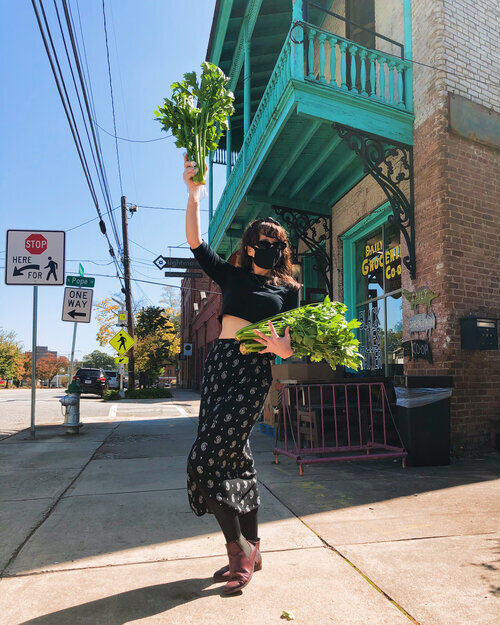By Lauren Cox
Lauren Cox is the Organic Procurement Coordinator at Georgia Organics
Aluma Farm’s very organized harvest board. Photo credit: Bailey Garrot.
Small farms operate much like other small entrepreneurial businesses. In addition to producing food, a farmer must also be a self-promoter, a marketer, their own research and development team, and very often juggle the wants and needs of a variety of customers. In the 6th installation of the Winter Webinar series, Farm to Restaurant’s Organic Procurement Coordinator leads a three-part webinar covering these activities: deciding on your basket of goods and services and creating a value statement, managing your weekly farm flow, and understanding how you divide up your farm based on your revenue streams.
Whether you sell at the farmers market, to restaurants, wholesalers, or through a CSA program, you should aim to know your customer base and plan for moving product. Photo by Lauren Cox.
There are multiple ways for farmers to get food to their final customers. This ‘farmer to eater’ supply chain can include processors, wholesalers, restaurants, grocery stores, and retailers or simply go directly into the hands of an eater. Farmers can sell to each of these groups and should understand that each one of them has different wants and needs, including where they hold value and what they are looking for when buying from a farmer.
This ‘basket of goods and services’ can also change over time depending on the farmer as well as the customer. While planning for the year ahead, ask yourself: What am I selling and why is it important to my customer? Remember, what is important to you isn’t necessarily going to be important to everyone else. Maybe your customer values being able to talk to you each week and ask questions about what they’re buying while you prioritize paying your employees fair wages and growing organically. One does not necessarily exclude the other but again, your customer’s values and where they’re prioritized might not be the same as your own.
Thinking about a value statement or value proposition is also important. This can change with your customers and correlates to your basket of goods and services. If you can’t make money from your basket of ‘goods and services’ then don’t do it and always make sure you have a feedback loop to understand if your customer’s values are changing. Easy ways to do this include talking to your customers directly as well as conducting surveys to market-goers and CSA members. Also watching what sells quickly and what doesn’t is a non-verbal way to assess your markets. No matter what, having a feedback loop gives a farmer the advantage to help plan for growing any of their revenue streams.
Planning for growth is important. Photo by Lauren Cox.
As you think about the year ahead and decide which customers and parts of your business will shift or grow, consider your current weekly farm schedule. Taking on more revenue streams could mean you take more time off the farm for market days. It could mean more time spent harvesting and delivering to wholesalers or restaurants. While planning, try this exercise: Make a column for each day of the week and then fill it with the general tasks you do consistently, for example, Monday’s are bookkeeping days, and Tuesday, Wednesday, and Thursday are workdays while Friday is a harvest day for Saturday market. Once this is done ask yourself, “Does my weekly flow feel well-paced? Is it packed in one part of the week and less busy in another? What if there were an emergency? Do I have enough time, in that case, to react? And finally, “Could I take on another sales channel?” Depending on your customer’s needs and values, you might be able to shift your schedule to take on new opportunities or give you that much-needed time on the farm you’ve been looking for.
Listing out your top sellers across your different markets can highlight your resiliency in withstands shifts in market demand. Photo by Lauren Cox.
How do we bring what we know about our customer base, our weekly bandwidth, and how we want to grow our business together to refine our systems and plan for the year ahead? First and foremost record-keeping is our biggest asset! Thinking about your ‘top sellers’ for each customer base and looking at your books to see if you’re making money on them can give you valuable insight (no pun intended) into whether or not you’re on the right track. Ideally, you should plan for growth and have multiple customers that are interested in the same thing in case one of them falls through. In addition to QuickBooks and surveys, keep a notebook with your weekly sales information. Walk around the first day of your workweek and write down what you need to sell, how much you have, and to whom you plan to sell it to (CSA, restaurants, markets, or otherwise).
This exercise will help you get better at understanding quantities of what you have to offer and how much space you are allocating on your farm for each sales outlet. As you think about the space on your farm and how it relates to your customer base ask yourself these questions: What isn’t selling to multiple customers? Are there other things I could use that farm space for? Are there other things I could sell to the same customers that also sell at other markets? Asking yourself these questions explicitly with give you a leg up in planning for growth and managing your revenue streams.
This Good Food for Thought event was a workshop exclusive to Georgia Organics Farmer Members. Interested in becoming a farmer member for just $12 per year? Visit membership.georgiaorganics.org/farmer-membership. Join us for more Good Food for Thought by visiting gfft.georgiaorganics.org/virtual-events.

















































